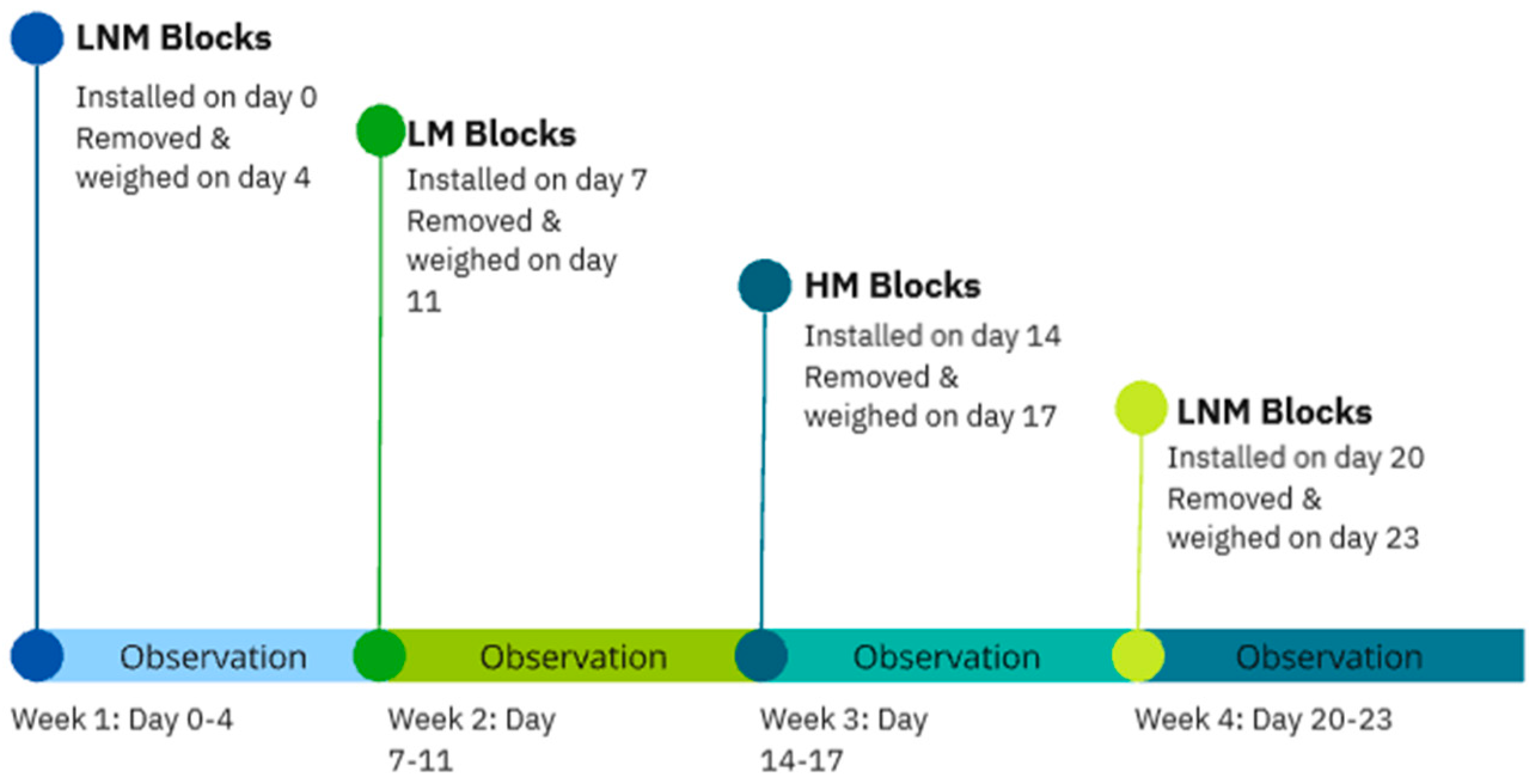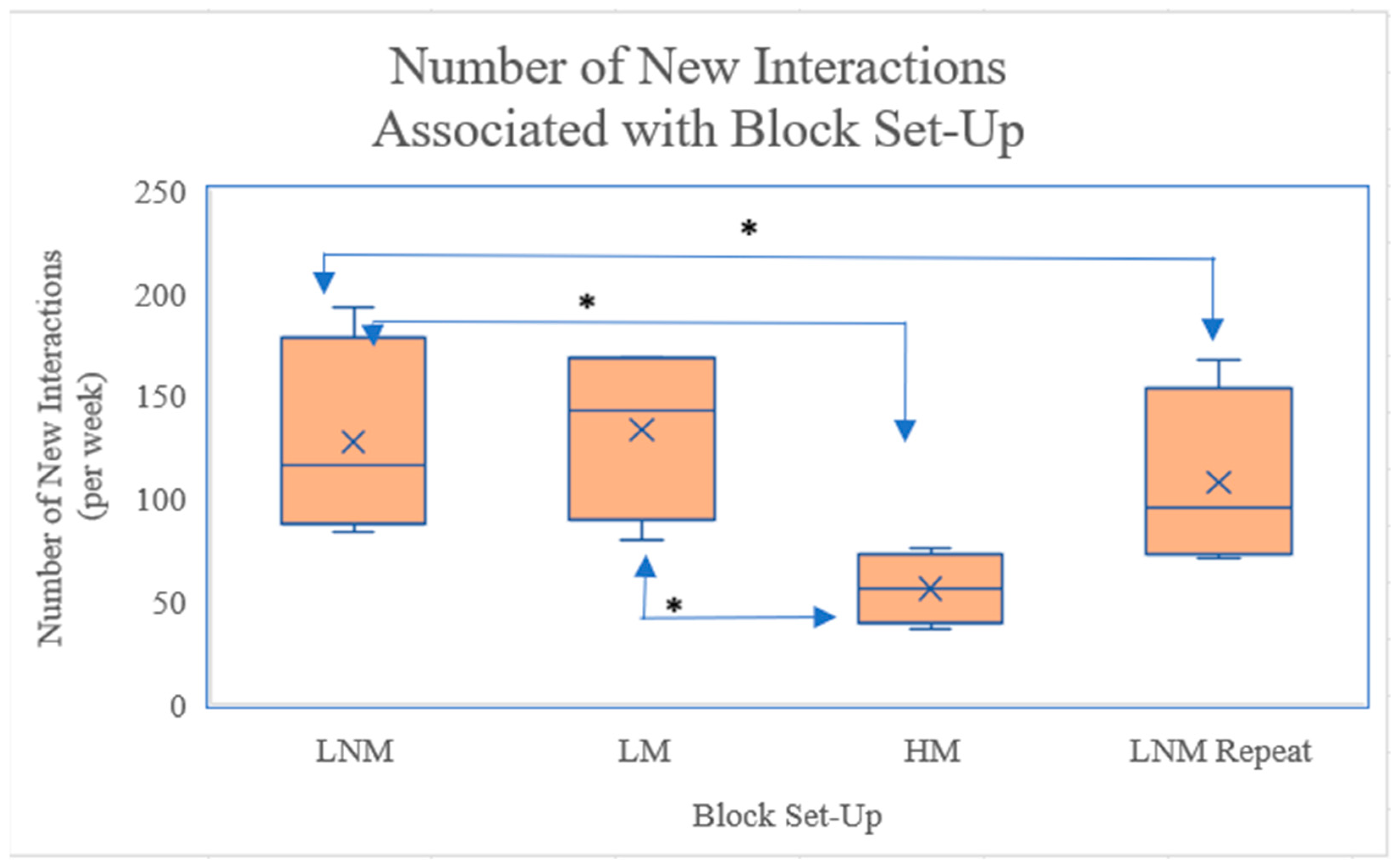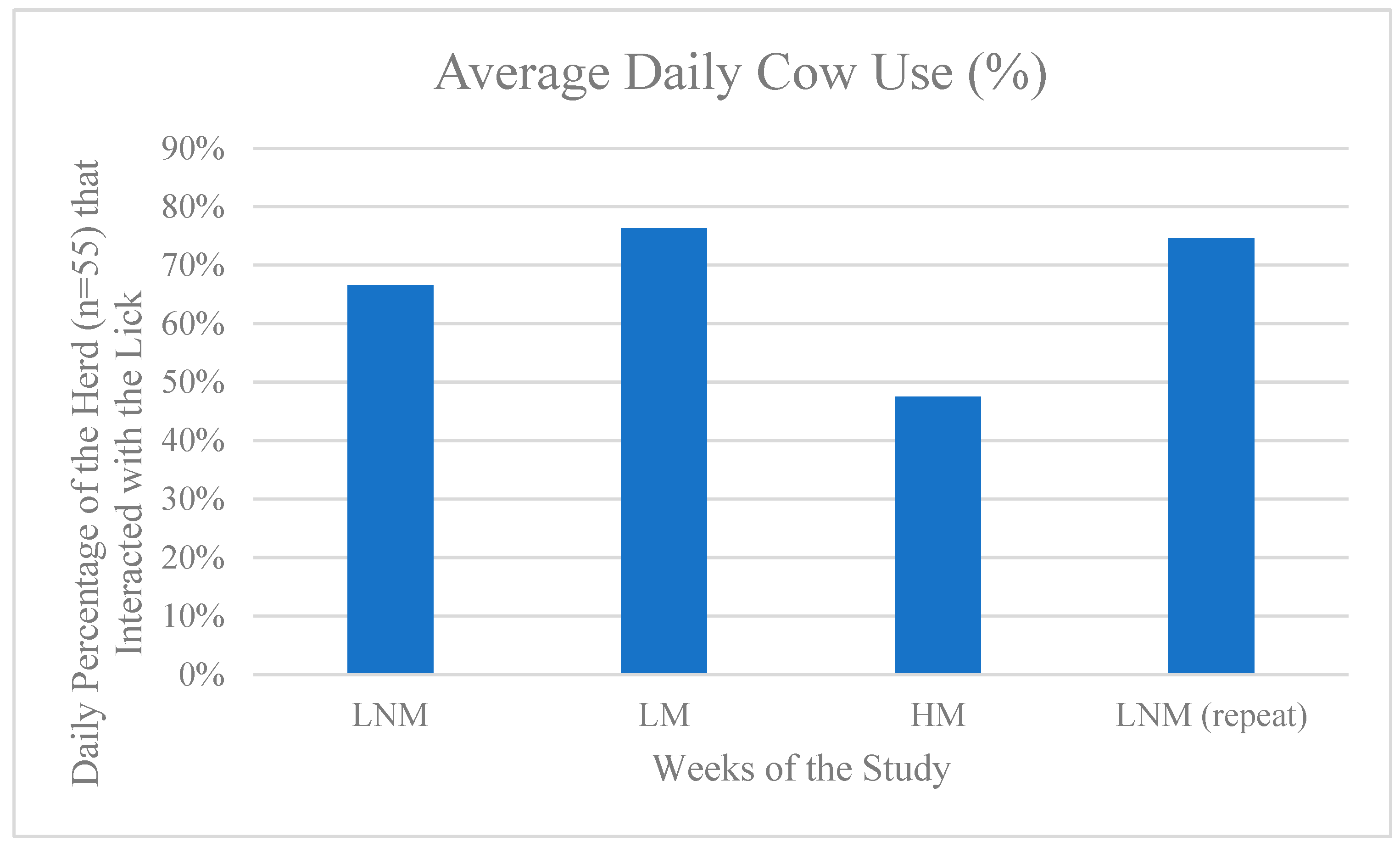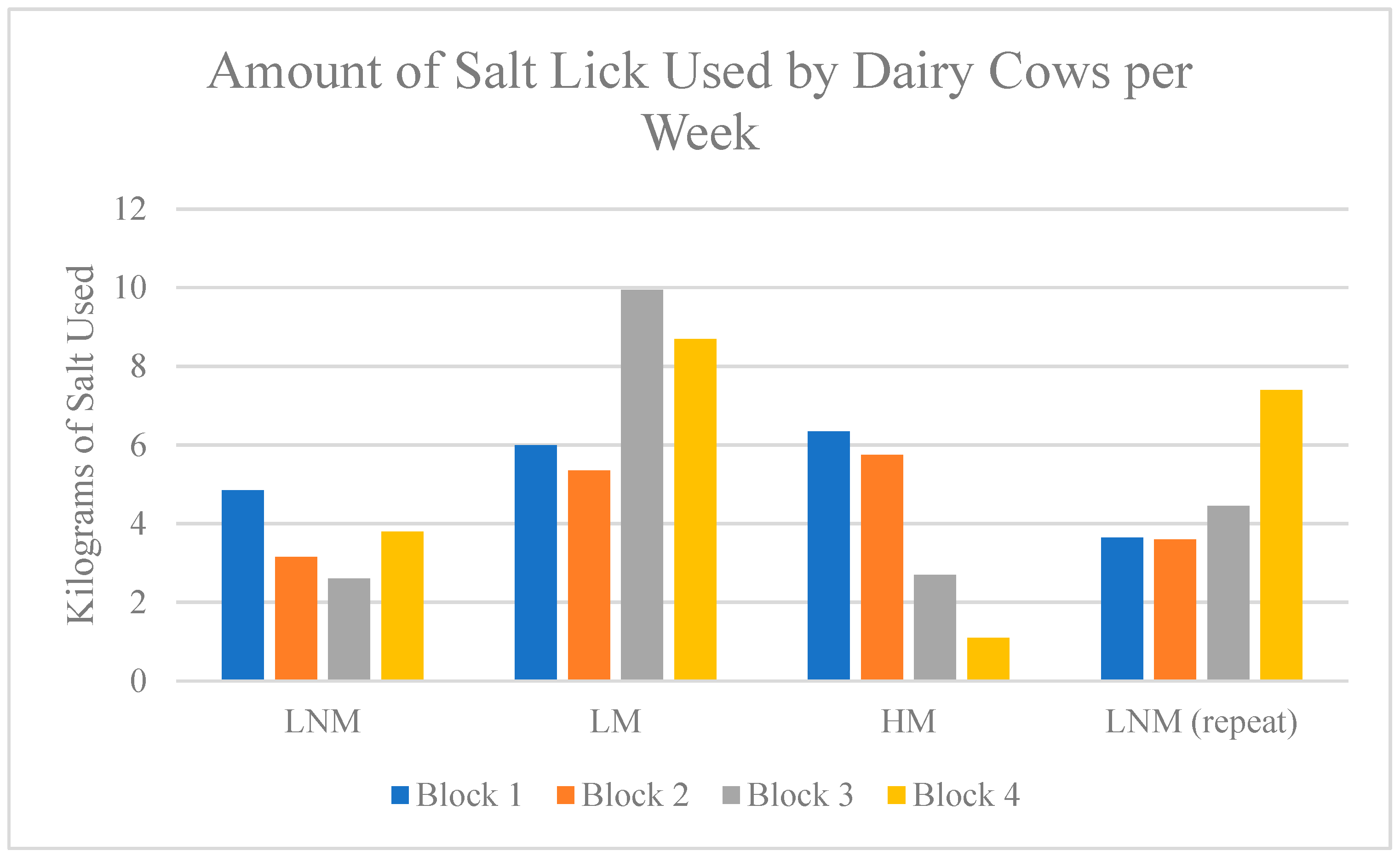Behavioural Engagement of Holstein Friesian Dairy Cattle with Different Mounting Techniques for Salt Licks as Environmental Enrichment
Simple Summary
Abstract
1. Introduction
1.1. Industry Standards
1.2. Defining Enrichment
1.3. Oral Stereotypies
1.4. Mineral Licks
1.5. Study Aims
2. Materials and Methods
2.1. Animals and Ethics Review
2.2. Building and Block Setup
2.3. Behavioural Observations
2.4. Statistical Analysis
3. Results
3.1. Assumptions
3.2. ANOVA
4. Discussion
4.1. Significant Findings
4.2. Habituation
4.3. Application
4.4. Limitations
5. Conclusions
Author Contributions
Funding
Institutional Review Board Statement
Informed Consent Statement
Data Availability Statement
Acknowledgments
Conflicts of Interest
Abbreviations
| LNM | Low Non-Moveable Mounting Setup |
| LM | Low Moveable Mounting Setup |
| HM | High Moveable Mounting Setup |
| DEFRA | Department for Environment Food and Rural Affairs |
References
- Shortall, O. Should cows graze? A relational approach to understanding farmer perspectives on the ethics of grazing and indoor dairy systems. Sociol. Rural. 2024, 64, 531–551. [Google Scholar] [CrossRef]
- van Vuuren, A.; van den Pol, A. Grazing systems and feed supplementation. In Fresh Herbage for Dairy Cattle: The Key to a Sustainable Food Chain; Elgersma, A., Ed.; Springer: Wageningen, The Netherlands, 2006; Volume 18, pp. 85–101. [Google Scholar]
- Schütz, K.E.; Clark, K.V.; Cox, N.R.; Matthews, L.R.; Tucker, C.B. Responses to short-term exposure to simulated rain and wind by dairy cattle: Time budgets, shelter use, body temperature and feed intake. Anim. Welf. 2010, 19, 375–383. [Google Scholar] [CrossRef]
- Algers, B.; Bertoni, G.; Broom, D.; Hartung, J.; Lidfors, L.; Metz, J.; Munksgaard, L.; Nunes, P.T.; Oltenacu, P.; Rehage, J.; et al. Scientific report on the effects of farming systems on dairy cow welfare and disease. EFSA J. 2009, 7, 1143. [Google Scholar] [CrossRef]
- Cavallini, D.; Mammi, L.M.E.; Fustini, M.; Palmonari, A.; Heinrichs, A.J.; Formigoni, A. Effects of ad libitum or restricted access to total mixed ration with supplemental long hay on production, intake, and rumination. J. Dairy Sci. 2018, 101, 10922–10928. [Google Scholar] [CrossRef] [PubMed]
- Newberry, R.C. Environmental enrichment: Increasing the biological relevance of captive environments. Appl. Anim. Behav. Sci. 1995, 44, 229–243. [Google Scholar] [CrossRef]
- Arlagården®. Farm Management Programme; Arla: Viby, Denmark, 2021; Available online: https://www.arla.com/4a54d6/globalassets/arla-global/arlagaarden/arlagardenrcatalogue.pdf (accessed on 9 January 2025).
- Red Tractor Assurance. Dairy Standards. Available online: https://redtractorassurance.org.uk/wp-content/uploads/2022/08/Dairy-V5-Standards-Aug-22-FINAL.pdf (accessed on 9 January 2025).
- Global Animal Partnership. Dairy Cattle Standards. Available online: https://globalanimalpartnership.org/standards/dairy-cattle/ (accessed on 9 January 2025).
- Red Tractor Assurance. Member Benefits 2023. Available online: https://redtractorassurance.org.uk/reap-the-rewards-with-red-tractor (accessed on 9 January 2025).
- Boissy, A.; Manteuffel, G.; Jensen, M.B.; Moe, R.O.; Spruijt, B.; Keeling, L.J.; Winckler, C.; Forkman, B.; Dimitrov, I.; Langbein, J.; et al. Assessment of positive emotions in animals to improve their welfare. Physiol. Behav. 2007, 92, 375–397. [Google Scholar] [CrossRef] [PubMed]
- Vicino, G.A.; Sheftel, J.J.; Radosevich, L.M. Enrichment Is Simple, That’s the Problem: Using Outcome-Based Husbandry to Shift from Enrichment to Experience. Animals 2022, 12, 1293. [Google Scholar] [CrossRef] [PubMed]
- De Paula Vieira, A.; von Keyserlingk, M.A.; Weary, D.M. Effects of pair versus single housing on performance and behavior of dairy calves before and after weaning from milk. J. Dairy Sci. 2010, 93, 3079–3085. [Google Scholar] [CrossRef] [PubMed]
- Hepola, H.; Hänninen, L.; Pursiainen, P.; Tuure, V.M.; Syrjälä-Qvist, L.; Pyykkönen, M.; Saloniemi, H. Feed intake and oral behaviour of dairy calves housed individually or in groups in warm or cold buildings. Livest. Sci. 2006, 105, 94–104. [Google Scholar] [CrossRef]
- Warnick, V.D.; Arave, C.W.; Mickelsen, C.H. Effects of Group, Individual, and Isolated Rearing of Calves on Weight Gain and Behavior. J. Dairy Sci. 1977, 60, 947–953. [Google Scholar] [CrossRef]
- Hillmann, E.; Roth, B.A.; Johns, J.; Waiblinger, S.; Barth, K. Dam-associated rearing as animal friendly alternative to artificial rearing in dairy cattle. Landbauforsch VTI AG 2012, 362, 181–183. [Google Scholar]
- Roth, B.A.; Barth, K.; Gygax, L.; Hillmann, E. Influence of artificial vs. mother-bonded rearing on sucking behaviour, health and weight gain in calves. Appl. Anim. Behav. Sci. 2009, 119, 143–150. [Google Scholar] [CrossRef]
- Valníčková, B.; Stěhulová, I.; Šárová, R.; Špinka, M. The effect of age at separation from the dam and presence of social companions on play behavior and weight gain in dairy calves. J. Dairy Sci. 2015, 98, 5545–5556. [Google Scholar] [CrossRef]
- Ninomiya, S.; Sato, S. Effects of ‘Five freedoms’ environmental enrichment on the welfare of calves reared indoors. Anim. Sci. J. 2009, 80, 347–351. [Google Scholar] [CrossRef] [PubMed]
- Hagen, K.; Broom, D.M. Emotional reactions to learning in cattle. Appl. Anim. Behav. Sci. 2004, 85, 203–213. [Google Scholar] [CrossRef]
- Castro, I.M.L.; Gygax, L.; Wechsler, B.; Hauser, R. Increasing the interval between winter outdoor exercise aggravates agonistic interactions in Hérens cows kept in tie-stalls. Appl. Anim. Behav. Sci. 2011, 129, 59–66. [Google Scholar] [CrossRef]
- Jensen, P.A.; Recén, B.; Ekesbo, I. Preference of loose housed dairy cows for two different cubicle floor coverings. J. Agric. Res. 1988, 18, 141–146. [Google Scholar]
- Piller, C.A.K.; Stookey, J.M.; Watts, J.M. Effects of mirror-image exposure on heart rate and movement of isolated heifers. Appl. Anim. Behav. Sci. 1999, 63, 93–102. [Google Scholar] [CrossRef]
- Gutmann, A. Verhalten von Milchkühen bei der Nutzung von fixen gegenüber rotierenden Bürsten. In Proceedings of the 24th Internationale Gesellschaft für Nutztierhaltung Conference, Las Vegas, NV, USA, 24 October 2020–24 January 2021; pp. 78–81. [Google Scholar]
- de Passillé, A.M. Sucking motivation and related problems in calves. Appl. Anim. Behav. Sci. 2001, 72, 175–187. [Google Scholar] [CrossRef]
- Jensen, M.B.; Weary, D. Group housing and milk feeding of dairy calves. Adv. Dairy Technol. 2013, 25, 179–189. [Google Scholar]
- Mandel, R.; Whay, H.R.; Klement, E.; Nicol, C.J. Invited review: Environmental enrichment of dairy cows and calves in indoor housing. J. Dairy Sci. 2016, 99, 1695–1715. [Google Scholar] [CrossRef] [PubMed]
- Lambeth, S.P.; Bloomsmith, M.A. Mirrors as enrichment for captive chimpanzees (Pan troglodytes). Lab. Anim. Sci. 1992, 42, 261–266. [Google Scholar] [PubMed]
- Gomez, A.; Cook, N.B. Time budgets of lactating dairy cattle in commercial freestall herds. J. Dairy Sci. 2010, 93, 5772–5781. [Google Scholar] [CrossRef]
- Cooper, M.D.; Arney, D.R.; Phillips, C.J.C. The effect of temporary deprivation of lying and feeding on the behaviour and production of lactating dairy cows. Animal 2008, 2, 275–283. [Google Scholar] [CrossRef] [PubMed]
- Ishiwata, T.; Uetake, K.; Kilgour, R.J.; Eguchi, Y.; Tanaka, T. Oral behaviors of beef steers in pen and pasture environments. J. Appl. Anim. Welf. Sci. 2007, 10, 185–192. [Google Scholar] [CrossRef] [PubMed]
- Sandem, A.I.; Braastad, B.O.; Bøe, K.E. Eye white may indicate emotional state on a frustration–contentedness axis in dairy cows. Appl. Anim. Behav. Sci. 2002, 79, 1–10. [Google Scholar] [CrossRef]
- Lindström, T.; Redbo, I.I. Effect of feeding duration and rumen fill on behaviour in dairy cows. Appl. Anim. Behav. Sci. 2000, 70, 83–97. [Google Scholar] [CrossRef] [PubMed]
- van de Weerd, H.A.; Day, J.E.L. A review of environmental enrichment for pigs housed in intensive housing systems. Appl. Anim. Behav. Sci. 2009, 116, 1–20. [Google Scholar] [CrossRef]
- Lata, M.; Mondal, B. Importance of salt feeding for livestock and poultry production. Vigyan Varta 2021, 2, 40–43. [Google Scholar]
- Grewal, R.; Lamba, J.; Ahuja, C.; Chhabra, S.; Kaur, S.; Kaur, J. Effect of free choice salt and mineral licks supplementation on milk production and blood biochemical parameters in crossbred cows. J. Anim. Res. 2016, 6, 915–919. [Google Scholar] [CrossRef]
- DeVries, T.J.; Vankova, M.; Veira, D.M.; von Keyserlingk, M.A.G. Short Communication: Usage of Mechanical Brushes by Lactating Dairy Cows. J. Dairy Sci. 2007, 90, 2241–2245. [Google Scholar] [CrossRef]
- Bulens, A.; Van Beirendonck, S.; Van Thielen, J.; Driessen, B. The effect of environmental enrichment on the behaviour of beef calves. In Proceedings of the 6th International Conference on the Assessment of Animal Welfare at Farm, and Group Level, Berlin, Germany, 19–21 November 2014; p. 235. [Google Scholar]
- Kim, D.-W.; Kim, Y.-H.; Min, Y.-J.; Yu, D.-J.; Jeong, Y.-D. Effects of floor type and hanging type environmental enrichment on the behavior of growing pigs. J. Korea Acad. Ind. Coop. Soc. 2017, 18, 282–289. [Google Scholar]
- Phillips, C.; Oevermans, H.; Syrett, K.; Jespersen, A.; Pearce, G. Lateralization of behavior in dairy cows in response to conspecifics and novel persons. J. Dairy Sci. 2015, 98, 2389–2400. [Google Scholar] [CrossRef]
- Zobel, G.; Neave, H.W.; Henderson, H.V.; Webster, J. Calves Use an Automated Brush and a Hanging Rope When Pair-Housed. Animals 2017, 7, 84. [Google Scholar] [CrossRef] [PubMed]
- Orihuela, A.; Mota-Rojas, D.; Velarde, A.; Strappini-Asteggiano, A.; Vega, L.d.l.; Borderas-Tordesillas, F.; Alonso-Spilsbury, M. Environmental enrichment to improve behaviour in farm animals. CABI Rev. 2018, 13, 25. [Google Scholar] [CrossRef]
- Hetti Arachchige, A.D.; Fisher, A.D.; Wales, W.J.; Auldist, M.J.; Hannah, M.C.; Jongman, E.C. Space allowance and barriers influence cow competition for mixed rations fed on a feed-pad between bouts of grazing. J. Dairy Sci. 2014, 97, 3578–3588. [Google Scholar] [CrossRef]
- The Oxford Dictionary; Oxford University Press: Oxford, UK, 1992.
- Russell, A.L.; Randall, L.V.; Kaler, J.; Eyre, N.; Thompson, J.; Green, M.J. Housed dairy cows utilise varied environmental enrichments and show diverse inter-individual variation in habituation. Appl. Anim. Behav. Sci. 2024, 274, 106241. [Google Scholar] [CrossRef]
- Woods, J.M.; Lane, E.K.; Miller, L.J. Preference assessments as a tool to evaluate environmental enrichment. Zoo Biol. 2020, 39, 382–390. [Google Scholar] [CrossRef] [PubMed]
- Jaster, E.H.; Schuh, J.D.; Wegner, T.N. Physiological Effects of Saline Drinking Water on High Producing Dairy Cows1, 2, 3. J. Dairy Sci. 1978, 61, 66–71. [Google Scholar] [CrossRef]
- Murphy, M.R. Water Metabolism of Dairy Cattle. J. Dairy Sci. 1992, 75, 326–333. [Google Scholar] [CrossRef]
- Razali, N.B.; Mansor, M.S.; Ismail, N.A.; Patah, P.A.; Husin, S.M.; Hussein, M.S.R.; Nor, S.M. The use of salt licks by birds in Peninsular Malaysia. Glob. Ecol. Conserv. 2022, 38, e02210. [Google Scholar] [CrossRef]
- Kelly, K.M. Effects of Environmental Enrichment on Behaviors, Growth, and Stress in Limit-Fed Holstein Heifers. Ph.D. Thesis, North Carolina State University, Raleigh, NC, USA, 2019. [Google Scholar]
- Burton, Y.I.; Blackie, N. Impact of Lameness on Brush Use in a Loose-Housed Dairy System. Ruminants 2024, 4, 375–386. [Google Scholar] [CrossRef]









| Treatment Name | Treatment Abbreviation | Height of Salt Lick from Ground | Movable | Week of Study |
|---|---|---|---|---|
| Low non-moveable | LNM | 30 cm | No | 1 and 4 |
| Low moveable | LM | 30 cm | Yes | 2 |
| High moveable | HM | 150 cm | Yes | 3 |
| Term | Definition |
|---|---|
| Interaction | The oral manipulation of a salt block by a cow |
| New Interaction | An interaction by a cow who was not observed at that block during the previous observation point |
| Individual Cow Interaction | The individual cow identified by ID tags who has partaken in an interaction |
| Total Individual Cow Interactions | The total number of individual cows, identified by ID tags, who have partaken in an interaction on a specific day |
| Cow ID | Number of Days a Block Was Used | Percentage of Days a Block Was Used (n = 20) |
|---|---|---|
| 620 | 17 | 85% |
| 413 | 16 | 80% |
| 612 | 16 | 80% |
| 665 | 16 | 80% |
| 630 | 15 | 75% |
| Cow ID | Total Cow Interactions |
|---|---|
| 620 | 118 |
| 413 | 117 |
| 612 | 89 |
| 665 | 88 |
| 630 | 82 |
| Week | Block Setup | Instances of Aggression | Description |
|---|---|---|---|
| 1 | LNM | 13 | Head-butting, Shoving, and Chasing |
| 2 | LM | 4 | Head-butting and Shoving |
| 3 | HM | 1 | Head-butting |
| 4 | LNM (repeat) | 3 | Head-butting and Chasing |
Disclaimer/Publisher’s Note: The statements, opinions and data contained in all publications are solely those of the individual author(s) and contributor(s) and not of MDPI and/or the editor(s). MDPI and/or the editor(s) disclaim responsibility for any injury to people or property resulting from any ideas, methods, instructions or products referred to in the content. |
© 2025 by the authors. Licensee MDPI, Basel, Switzerland. This article is an open access article distributed under the terms and conditions of the Creative Commons Attribution (CC BY) license (https://creativecommons.org/licenses/by/4.0/).
Share and Cite
McLaughlin, D.L.; Blackie, N. Behavioural Engagement of Holstein Friesian Dairy Cattle with Different Mounting Techniques for Salt Licks as Environmental Enrichment. Animals 2025, 15, 701. https://doi.org/10.3390/ani15050701
McLaughlin DL, Blackie N. Behavioural Engagement of Holstein Friesian Dairy Cattle with Different Mounting Techniques for Salt Licks as Environmental Enrichment. Animals. 2025; 15(5):701. https://doi.org/10.3390/ani15050701
Chicago/Turabian StyleMcLaughlin, Danielle Lauren, and Nicola Blackie. 2025. "Behavioural Engagement of Holstein Friesian Dairy Cattle with Different Mounting Techniques for Salt Licks as Environmental Enrichment" Animals 15, no. 5: 701. https://doi.org/10.3390/ani15050701
APA StyleMcLaughlin, D. L., & Blackie, N. (2025). Behavioural Engagement of Holstein Friesian Dairy Cattle with Different Mounting Techniques for Salt Licks as Environmental Enrichment. Animals, 15(5), 701. https://doi.org/10.3390/ani15050701





